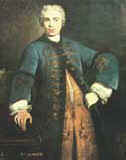|
What makes a piece of music popular? It may be an irresistible melody, like
a Schubert song that is immediately remembered, or the fascinating rhythm of
Ravel’s Bolero. Perhaps it is the magnificent orchestral arrangement
in some romantic masterpieces or the perfectly balanced simplicity of a
Baroque trumpet concerto. In any case, it is likely to be a combination of
rhythm, harmony, melody and emotional content plus an inexplicable element
that adds its own unique appeal.
The components that make a piece of Baroque music popular today are no doubt
different from those that appealed to the audiences of the 18th
century. For example, several of Händel’s great operas were opening-night
fiascos, and the music of J. S. Bach (perhaps the major composer of the second
millennium) today performed to great acclaim, was spurned in his day as being
too complicated and old fashioned. On the other hand, the most published
piece of music in the 18th century was the Stabat Mater by
Pergolesi – a sacred work that, although incredibly beautiful, only enjoys
limited success today. Generally, however, many Baroque compositions
have become very popular in our time, due to a remarkable revival of interest
in 18th century music. Perhaps one of the reasons is that this
music seems to transmit a serenity and upbeat belief in the future that is
both inspiring and comforting at times when our own age seems confused and
unsettled.One
of the main characteristics of Baroque music is the emphasis placed on
virtuosity. Highlighting this was the development of instrumental forms,
including the sonata and suite. String instruments, the violin in particular,
were greatly favoured as were the wind instruments such as the flute, oboe
and trumpet.
In the spirit and range of Baroque music, one must not forget the importance
of the opera that, at the time, propelled certain castratos – prima donnas –
to great fame. The first castratos came from Spain and were employed at the
Sistine Chapel to take soprano parts. Women were not allowed to take part in singing of religious
services, therefore the parts were sung by young boys. However, at puberty
their voices broke forcing the chapels to continue to employ new boys.
|

Carlo Broschi better known as Farinelli
|
The castrato would keep his soprano voice
all his life and therefore provide an ideal solution to the
problem. The castration of young boys gifted with a good voice would mean
hope of social improvement for his family. Therefore, from about 1600 the
number of castratos aspiring to learn music increased considerably. One of
the most famous castratos was Carlo Broschi, better known as Farinelli. It
is believed that Farinelli originally performed the works numbered six,
seven, eight, ten and fourteen recorded on this CD. Two of the pieces were
composed by his brother Riccardo Broschi who was later accused of copying
music from works written by Händel and Hasse. Whatever the truth, it is
incredibly beautiful music.
Although
the Baroque period is dominated by the twin giants of Bach and Händel, the
group of composers featured on this recording inspired and contributed much
to the spirit and style of the time. All helped to illuminate a part of that
remarkable musical world we call the Baroque and is abundantly demonstrated
here in the sense of occasion and supreme self-confidence that flow from the
Unique Baroque Musique selected for this album.
|
|